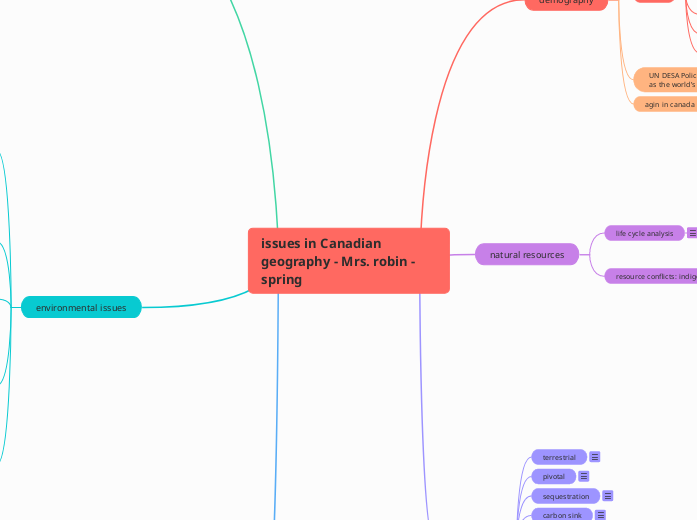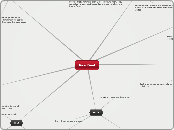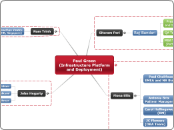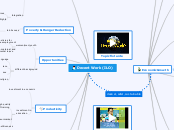issues in Canadian geography - Mrs. robin - spring
word wall
infrastructure
infrastructure is defined as the basic physical systems of a business, region, or nation and often involves the production of public goods or production processes. examples of infrastructure include transportation systems, communication networks, sewage, water, and school systems.
socio- cultural
definition. sociocultural" refers to a wide array of societal and cultural influences that impact thoughts, feelings, behaviors, and ultimately health outcomes.
overexploitation
the act of using too much of something, especially a natural resource (=minerals, forests, coal etc. that exist in a place and can be used by people): man's over-exploitation of the earth's resources has led to more through overexploitation by fisheries.
status quo
the status quo is the current state of things. if you are rich and admired, then you're probably not interested in disrupting the status quo. status quo is latin for "existing state. when we talk about the status quo, however, we often mean it in a slightly bad way.
paradigm
1 a typical example or pattern of something; a model.
2 a set of linguistic items that form mutually exclusive choices in particular syntactic roles.
demographic
demographics are statistics that describe populations and their characteristics. demographic analysis is the study of a populations-based on factors such as age, race, and sex.
carbon sink
a forest, ocean, or other natural environment viewed in terms of its ability to absorb carbon dioxide from the atmosphere.
sequestration
1 the action of taking legal possession of assets until a debt has been paid or other claims have been met.
2 the action of sequestering a substance.
pivotal
of crucial importance in relation to the development or success of something else.
terrestrial
1 : of or relating to the earth or its inhabitants
2 : living or growing on land
3 : belonging to a class of planets that are like the earth (as in density and silicate composition)
natural resources
resource conflicts: indigenous land protectors
- a social or political conflict where natural resources contribute to the onset, aggravation, or sustaining of the conflict, due to disagreements or competition over the access to and management of natural resources, and the unequal burdens and benefits, profits, or power generated thereof.
- often, defenders are members of indigenous communities who are protecting property rights of ancestral lands in the face of expropriation, pollution, depletion, or destruction.
wet'suwet'en supporters and RCMP standoff over pipeline
- the wet'suwet'en are a branch of the dakelh or carrier people, and in combination with the babine people have been referred to as the western carrier.
- royal Canadian mounted police (RCMP), canada's federal police force.
- a situation in which neither side has won a competition or argument, or an occasion when someone prevents officials from acting, usually by threatening violence: the battle of wills between teacher and student was a standoff.
- a very long large tube, often underground, through which liquid or gas can flow for long distances.
fracking new brunswick
- a moratorium on shale gas development in new Brunswick was put in place in 2014. the liberal government introduced the fracking ban a year after violent demonstrations took place in rexton near the first nations community of elsipogtog in 2013.
- fracking is a process that stimulates natural gas or oil in wellbores to flow more easily by subjecting hydrocarbon reservoirs to pressure through the injection of fluids or gas at depth causing the rock to fracture or to widen existing cracks.
mi'kmaq lobster fishery
the 2020 mi'kmaq lobster fishery dispute is an ongoing lobster fishery dispute between sipekne'katik first nation members of the mi'kmaq and non-indigenous lobster fishers mainly in digby county and Yarmouth county, Nova scotia.
life cycle analysis
quantifies the environmental impacts associated with a given product.
transportation
the movement of goods and persons from place to place and the various means by which such movement is accomplished.
demography
agin in canada
the old people don't have doctors.
UN DESA Policy Brief No. 153: India overtakes China as the world’s most populous country
china used to have more people in the country and now india has more people.
terms
childhood mortality rates
the child mortality rate is the number of deaths in a given year, expressed either per 1000 or 100,000 children in this age group. because child death is a rare event, child mortality rates are presented by larger geographical regions.
infant mortality rates
infant mortality rates refers to the number of deaths of children under one year of age during a given year per 1,000 live births (or 100,000 live births).
life expectancy
the term life expectancy refers to the number of years a person can expect to live. by definition, life expectancy is based on an estimate of the average age that members of a particular population group will be when they die.
net migration
the number of immigrants minus the number of emigrants, including citizens and noncitizens.
natural increase rate
the birth rate minus the death rate of a particular ...
death rates
birth rates
the number of births for every hundred or every thousand persons in a given area or group during a given time.
overpopulation
overpopulation is the state whereby the human population rises to an extent exceeding the carrying capacity of the ecological setting. in an overpopulated environment, the numbers of people might be more than the available essential materials for survival such as transport, water, shelter, food or social amenities.
population pyramids
the population pyramids represents the breakdown of the population by gender and age at a given point in time. it consists of two histograms, one for each gender (by convention, men on the left and women on the right) where the numbers are shown horizontally and the ages vertically.
sustainability/ sustainable development
caribou in canada
forest fires are not helping caribou.
plastic solutions
changing our everyday behaviors an not using plastic when there is a better alternative to it
plastic pollution
plastic pollution is the accumulation of plastic objects and particles (e.g. plastic bottles, bags and micro beads) in the earth's environment that adversely affects humans, wildlife and their habitat. plastics that act as pollutants are categorized by size into micro-, meso-, or macro debris.
circular economy
the circular economy is a system where materials never become waste and nature is regenerated. in a circular economy, products and materials are kept in circulation through processes like maintenance, reuse, refurbishment, remanufacture, recycling, and composting.
Ellen macarthur foundation
we're a charity committed to creating a circular economy, which is designed to eliminate waste and pollution, circulate products and materials (at their highest value), and regenerate nature. it's an economic system that delivers better outcomes for people, and the environment. Ellen macarthur foundation.
Canadian government
canada is a constitutional monarchy and a parliamentary democracy, founded on the rule of law and respect for rights and freedoms. the government acts in the name of the crown but derives its authority from the Canadian people. canada's parliamentary system stems from the British, or westminster", tradition.
European union parliament
the European parliament is the eu's law-making body. it is directly elected by eu voters every 5 years. the last elections were in May 2019.
the story of stuff
the story of stuff is a 20-minute, fast-paced, fact-filled look at the underside of our production and consumption patterns. the story of stuff exposes the connections between a huge number of environmental and social issues, and calls us together to create a more sustainable and just world.
environmental issues
plastic
an artificial substance that can be shaped when soft into many different forms and has many different uses: he put a sheet of plastic over the broken window. those flowers aren't real - they're made of plastic.
we urgently need a global plastics treaty
thus, a treaty goal is to ensure all governments and businesses play by the same, binding rules for plastic production, reuse and disposal. this will make it easier and more cost effective for all manner of realize their full potential to make an impact.
the problem with plastic pollution in Rio montagua, guatemala
guatemala Rio motagua contains three percent of the world's plastic pollution. garbage collection is nonexistent in most of the country. the 426-kilometre-long river is covered in plastic. for several decades, the green hills north of the capital have given way to mounds of garbage.
electricity
- a form of energy resulting from the existence of charged particles (such as electrons or protons), either statically as an accumulation of charge or dynamically as a current.
- a state or feeling of thrilling excitement. the atmosphere was charged with a dangerous sexual electricity
which industries produce the most GHGs?
transportation (28% of 2021 greenhouse gas emissions) - the transportation sector generates the largest share of greenhouse gas emissions. greenhouse gas emissions from transportation primarily come from burning fossil fuel for our cars, trucks, ships, trains, and planes.
electricity sources information
renewable sources of electricity include wind, hydropower, solar power, biomass, and geothermal. together, these sources generated about 20% of the country's electricity in 2022. to produce electricity, a turbine generator set converts mechanical energy to electrical energy.
google data center
google data centers are the large data center facilities google uses to provide their services, which combine large drives, computer nodes organized in aisles of racks, internal and external networking, environmental controls (mainly cooling and humidification control), and operations software (especially as concerns ...
phantom power
phantom power, also called standby power, refers to the energy that's wasted around your home when devices are plugged in and using power, but you're not actively using them.
where does ontario's electricity come from
about half of our electricity comes from nuclear power. the remainder comes from a mix of hydroelectric, coal, natural gas and wind. most of ontario's electricity generating stations are located in the southern half of the province close to where the demand for power is greatest.
landfill- garbage and waste problems
ontarians and now sending almost 12 million tonnes of waste to landfills every year. that's 70 per cent of the material we throw out despite efforts to improve waste diversion with blue boxes and green bins. in 2018, ontario residents sent 750,000 more tonnes of waste per year to landfills than in 2008.
the waste in our systems
the 8 waste
- overproduction
- waiting
- inefficient operations
- transport
- inventory
- motion
- poor quality
- misused resources.
how harnessing methane from landfills could help Canada fight climate change
getting the emissions down. many landfills manage methane by drilling wells into the piles of garbage and piping out the gas. the gas can be burned off in a flare. the energy from burning methane can also be used to generate electricity.
landfills are methane super- emitters
satellite data finds landfills are methane 'super emitters' a study builds on research that shows landfills are the third-largest source of methane emissions globally, after oil and gas systems and agriculture.
climate change
climate change refers to long-term shifts in temperatures and weather patterns. human activities have been the main driver of climate change, primarily due to the burning of fossil fuels like coal, oil and gas.
natural vs. human enhanced greenhouse effect
the natural greenhouse effects are due to the natural occurrence of greenhouse gases in the atmosphere. because of the natural greenhouse effect, earth is warm and supports life. the enhanced greenhouse effect are due to human activities that have led to high concentrations of greenhouse gases in the atmosphere.
earth's energy balance
the earth-atmosphere energy balance is the balance between incoming energy from the sun and outgoing energy from the earth. energy released from the sun is emitted as shortwave light and ultraviolet energy.
biodiversity
biodiversity is all the different kinds of life you'll find in one area-the variety of animals, plants, fungi, and even microorganisms like bacteria that make up our natural world. each of these species and organisms work together in ecosystems, like an intricate web, to maintain balance and support life.
the 4 components of habitat
the 4 components of habitat are:
food
water
shelter
space
sufficient
why care about biodiversity
without a wide range of animals, plants and microorganisms,we cannot have the healthy ecosystems that we rely on to provide us with the air we breathe and the food we eat.
bees
wasps
bats
birds
hornets
insects
all species are connected through food web.
wwf Canada living planet report
canada living planet report is a comprehensive study of trends in global biodiversity and the health of the planet.
living planet report
average numbers within species have declined by 69%!!!
explore the site and write down some notes about what you learned.....
ecosystem biodiversity
ecosystem biodiversity is having a variety of healthy, intact ecosystems on the planet.
species biodiversity
species biodiversity is having many different types of species.
genetic biodiversity
genetic biodiversity is the biological variation that occurs within species. it makes it possible for species to adapt when the environment changes.
physical geography
physical processes
physical processes are the natural forces that change earth's physical features, including forces that build up and wear down earth's surface. you have a thorough understanding of how four physical processes-tectonic movement, volcanic activity, erosion, and glaciation-have shaped earth's surface.
wearing down processes
attrition. a wearing down to weaken or destroy; "a war of attrition erosion by friction.
building up processes
the act or process of building up.
rock cycle
many of earth's key processes function in cycles and rock cycle is no exception. the rock cycle is a web of processes that outlines how each of the three major rock types-igneous, metamorphic, and sedimentary-form and break down based on the different applications of heat and pressure over time.
landform regions
a landform region is an area of the earth with a unique set of physical features.
great lakes and st. lawrence lowlands
great lakes st. Lawrence lowlands is a physiographic region of eastern Canada
innuitian mountains
innuitian mountains is derived from innuit, a term applied by the eskimos of alaska to themselves.
Hudson bay and arctic lowlands
hudson bay lowlands is an inland sea in ne Canada and arctic lowlands is one of the geographic regions in Canada.
appalachian mountains
appalachian mountains is a mountain range in the eastern united states extending from Quebec to the gulf of Mexico
interior plains
interior plains is a vast physiographic region that spreads across the laurentian craton of central north America
Canadian shield
canadian shield is the exposed portion of the continental crust underlying the majority of north America.
western cordillera
the western cordillera is a system of mountain ranges extending from the u.s. state of alaska through northwestern canada, the western united states, and into Mexico.









